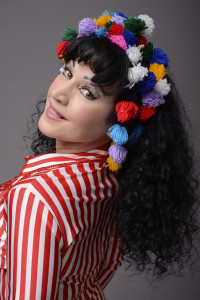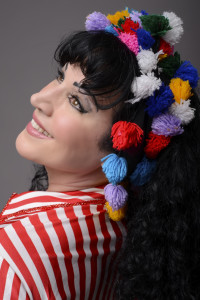
 Background
Background
Belonging to folklore, Beledi or Raks Beledi is a basic, earthy, traditional Egyptian style of women’s dance. The word Beledi translated simply means “of the country” or “of the town”. Beledi is the populaire or Shaabi of the Egyptians. Finger cymbals are sometimes used as well as a stick (cane). Today it can be fused with Egyptian Pop for a more modern, fun version of today’s generation, giving it both traditional and modern elements that create a new style and look.
The word Beledi for many dancers means a style of dance that has many variations of 4/4 rhythms e.g., maksoum (D TTT D TT), masmoudi saghir (DD TT D TT), saidi (D T DD T) and 2/4 rhythms e.g., fallahi (D s-tek) and 8/4 rhythms e.g., masmoudi kabir (DD Ts-tek D tek-a tek-a tek-a). For many musicians, Beledi refers to a rhythm, which dancers call maksoum.
 A typical Beledi can sometimes have three or four components that include a taqsim, question and answer (Tet or Awwadi) and Beledi (4/4 part in which the pace is picked up) and a drum solo (which may or may not be present). A Beledi can also be referred to as taqsim baladi or baladi awadi. Beledi is almost always improvised and not choreographed.
A typical Beledi can sometimes have three or four components that include a taqsim, question and answer (Tet or Awwadi) and Beledi (4/4 part in which the pace is picked up) and a drum solo (which may or may not be present). A Beledi can also be referred to as taqsim baladi or baladi awadi. Beledi is almost always improvised and not choreographed.
Beledi can also be a part of a Raks Sharqi routine and although it is folkloric in character and music, it is definitely a dance in itself showing emotion, feeling and expression, thus why it is improvised. Raks Sharqi, evolved from Beledi, and is a more refined, sophisticated and choreographed version of the solo dance, performed to intricate musical arrangements. Beledi style music can also be used for Malaya Lef, another Egyptian folkloric dance from Alexandria.
Music: Beledi starts slowly and progresses up to the very end. It mostly begins with a taqsim, which is a slow, improvised section of music, usually played on one instrument and with no rhythmical accompaniment. It can have an almost haunting beginning and has a fun and happy ending.
Next comes the “tet” or “awwadi”, (awwadi means to repeat) the question and answer part that normally has sharp accents on the “one-and” counts and instrumental “answers” for the remainder of the four-beat bar. A variation of the tet/awwadi, which is found quite frequently in Egyptian music, is the magrour. This term actually means pulled or dragged along, a rather broken interplay between percussion and melodic instruments. (In Tunisian dance Awwada (Aouada) means a group of musicians)
 Next comes a large and powerful baladi which consists of a 4/4 rhythm with accents on the “one-and . . . three”. This can alternate with masmoudi kabir, saidi or maksoum. Then as the pace picks up, the Beledi makes a transition into a rapid section of 2/4 beat called fellahi, named after the Egyptian farmers or fellahin.
Next comes a large and powerful baladi which consists of a 4/4 rhythm with accents on the “one-and . . . three”. This can alternate with masmoudi kabir, saidi or maksoum. Then as the pace picks up, the Beledi makes a transition into a rapid section of 2/4 beat called fellahi, named after the Egyptian farmers or fellahin.
Finally, the music begins to wind down and resolves into a final taqsim, which may or may not be followed by a drum solo, according to the individual preference of the dancer.
Costume: The costume for Raks Beledi is typically an ankle-length, tight-fitted simple dress called a thobe or beledi dress and worn with a scarf or fringed belt tied around the hips. Dresses made of Assuit (black fabric embossed with silver) are also worn for a more traditional look.
References: My dear friend Nadia Hamdi, Cairo, Egypt and the Late Salah Mohammed Hamdi (brother of Abdel Wahab Mohammed, known lyrics accompanist), Salah Rahbiah, former Director of Baloon heater and one fo the best ney players in Egypt.